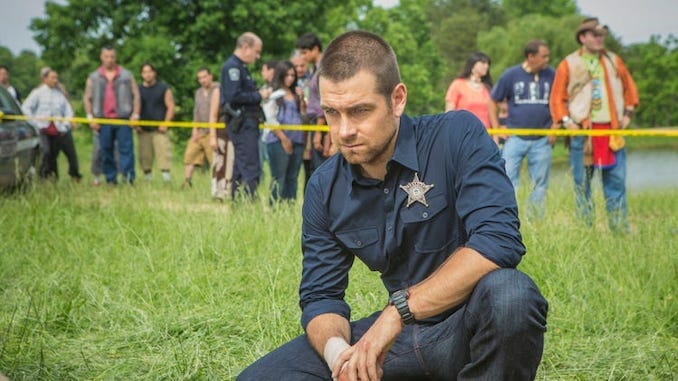It Still Stings: The Death of Cinemax, One of Peak TV’s Greatest Experiments
Photo Courtesy of Cinemax
Editor’s Note: TV moves on, but we haven’t. In our feature series It Still Stings, we relive emotional TV moments that we just can’t get over. You know the ones, where months, years, or even decades later, it still provokes a reaction? We’re here for you. We rant because we love. Or, once loved. And obviously, when discussing finales in particular, there will be spoilers:
![]()
Despite the overwhelming number of shows that continue to beg for viewers’ attention every week, I can’t help but want more. To be more precise, I want more of a specific type of show: one that delivers heart-stopping action and viscerally engaging storytelling, all within the confines of the weekly episodic format. For the better part of the 2010s, shows like that did exist, and one network in particular excelled at producing (or co-producing) them: Cinemax. It’s a shame, then, that the premium cable network—which is owned by WarnerMedia and has been operating under the same roof as HBO since 1980—was essentially dismantled to make room for HBO Max. And it’s especially unfortunate because some of Cinemax’s shows still aren’t available to stream on the platform.
What began as a pay cable network focusing solely on movies that could complement HBO’s programming, Cinemax eventually evolved to include, most notably (infamously?) adult-oriented fare as part of its Max After Dark programming block. This led to a pervy reputation and a mocking but apt nickname: Skinemax. However, in 2011, intending to change and improve its reputation, the premium network took the first steps toward revamping itself once more by moving into the original content sphere.
With the debuts of the military-themed drama Strike Back—a co-production with the U.K.’s Sky One beginning with Season 2—and the British import Hunted, Cinemax began the slow rise out of pervatory to take its first steps toward becoming a legitimate network. While the latter would not live beyond one season, Strike Back—which appealed to the network’s key male demographic—quickly proved to be the backbone of its lineup. The show was then softly rebooted after the first season to be less somber and more fun. It starred Sullivan Stapleton and Philip Winchester as elite soldiers working to stop terrorists and other nefarious criminals around the globe. Airing from 2011 until 2015 and featuring high-octane, movie-worthy action sequences, Strike Back was often better than it had any right to be, especially given how much of the early Cinemax-produced seasons still adhered to the Skinemax M.O. of gratuitous sex and nudity. It was eventually revived and rebooted in 2017, trading the bromance that defined the Stapleton and Winchester era for an ensemble cast led by Daniel MacPherson, Warren Brown, and Alin Sumarwata. As the show aged, it grew stronger and more confident in its ability to pull off thrilling action and fight scenes while also developing its leads and telling more meaningful stories about them and the human cost of the job. When you look at the television landscape today, few shows fit that bill.
But Strike Back is hardly the only show for which Cinemax is known. Although the drama enjoyed a relatively long run on the network and was a reliable performer, it’s not likely to be the first series to be mentioned in conversations about Cinemax. No, that would be the four-season crime drama Banshee from co-creators Jonathan Tropper and David Schickler. A homegrown production premiering in 2013, Banshee followed an ex-con (Antony Starr) who, upon release from prison after 15 years, tracked his ex (Ivana Milicevic) to the small town of Banshee, Pennsylvania, where he took over the identity of the sheriff. For four years, the pulpy and violent action drama with big dreams (and a surprisingly big heart) explored the thrilling drama of small-town power dynamics and organized crime while dabbing in emotional stories about second chances, found family, and fatherhood. And it was all set against the backdrop of not just Banshee but also the local Amish and Native American communities. It was a compelling, multi-layered drama that at times drew more viewers than some HBO programs, and yet flew under the radar because the company wouldn’t dare promote Cinemax’s success over HBO.
Another high point was the early 1900s-set medical drama The Knick. The show, created by Jack Amiel and Michael Begler and directed by Steven Soderbergh, starred Clive Owen as a cocaine and opium-addicted surgeon at a New York hospital. With a Peabody Award and six Emmy nominations to its name, the series is the most acclaimed program Cinemax ever had. But it struggled to find an audience and was canceled after two seasons once HBO—which had taken charge of the show—became unwilling to foot the bill. Similarly short-lived was Quarry, a violent neo-noir that would not have been out of place on HBO or the version of FX that existed during the heyday of Sons of Anarchy, Justified, and The Americans. Based on the novels of Max Allan Collins and set in 1970s Memphis, Quarry featured an excellent soundtrack and followed a disgraced Marine (Logan Marshall-Green) who, after returning home from Vietnam and finding himself an outcast in his own country, became a gun for hire.
-

-

-

-

-

-

-

-

-

-

-

-

-

-

-

-

-

-

-

-

-

-

-

-

-

-

-

-

-

-

-

-

-

-

-

-

-

-

-

-








































